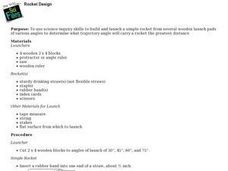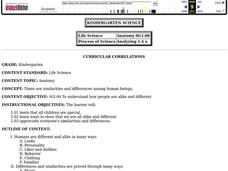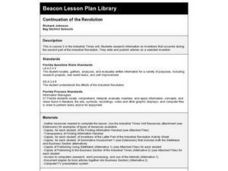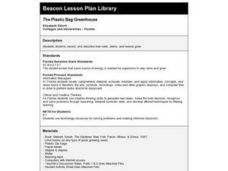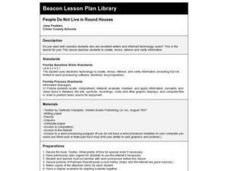Curated OER
WWII Economics
High schoolers simulate a classroom rationing program resembling an environment similar to the coupon/stamp rations conducted during WWII. The simulation last 3 days resulting in an observable outcome in relationship to the coupon...
Curated OER
What's Bright Red and Invisible?
Students study that very little sunlight penetrates the ocean below depths of 200 meters. They study that no light penetrates the ocean below depths of 1000 meters. They study that the quality of light changes as depth increase
Curated OER
Rocket Design: Aerodynamics, Trajectories
High schoolers use science inquiry skills to build and launch a simple rocket, from several wooden launch pads of various angles, to determine what trajectory angle carry a rocket the greatest distance.
Curated OER
What Is Industrial Design?
Students explore the processes used by industrial designers to design useful, safe, and appealing mass-produced objects. They select an object from their home or classroom and redesign it to improve its function, feel, and/or appearance.
Curated OER
Create a Fan Design
Students design fans with organic shapes and contrasting colors. They recognize t'aeguk design as a visual element of Korean culture.
Curated OER
Mystical Chinese
Students relate environmental influences to human situations through Feng Shui, describe various traditional Chinese medical practices, and explore the use of natural forces in Chinese medicine.
Curated OER
Japanese Fans
Fourth graders, understanding that fans are part of the cultural tradition of Japan, create fans that incorporate design techniques and ornamentation similar to that used in Japan. They also use the fan as an aid to expressive action.
Curated OER
Animals: Here and Now
Discuss and identify natural habitats of animals commonly found in zoos. The class constructs and displays small "zoo like" models to show a chosen animal habitat. They write a short story or diary about an animal or pet of their choice....
Curated OER
Flying High With Hot Air Balloons!
Sixth graders demonstrate an understanding of a narrative story by listening, speaking, reading and writing activities. They create two visual products that reflect the understanding of events, vocabulary, and characters.
Curated OER
Reaching the Clouds for Equality
Students listen to Martin Luther King's "I Have a Dream" speech. They create their own cloud and write a dream they have for the world inside. They write journal entries on how to treat others fairly.
Curated OER
Suspension Bridge Construction
Students build a model of a suspension bridge and test the amount of weight it support. They identify different types of bridges: suspension, arch, girder, truss, cantilever, cable-stayed and moveable.
Curated OER
"Bingo Brown and the Language of Love" by Betsy Byars
Students read the book, "Bingo Brown and the Language of Love" and discuss and define credit, loan, interest, and service credit. They complete activity sheets comparing advantages and disadvantages of using cash and credit.
Curated OER
Anatomy
Students explore the similarities and differences in human beings. They consider that all students are special, and appreciate everyone's similarities and differences.
Curated OER
Figure Cut-Outs
Students create large-scale 3 dimensional forms out of 2-dimensional material. They draw figures in various positions on lightweight poster board. Then they cut them out and fit them together and stapled or taped them into place on a base.
Curated OER
My Water's Place in Space
Pupils discover their absolute and relative place in space relative to water and create a book sequencing that space from most specific to most general.
Curated OER
Geo Jammin' By DeSign - Day 2, Lesson 9: Bringing It To A Fine Gloss-ary
Students create a glossary of geometric terms while exploring tangram manipulatives.
Curated OER
Continuation of the Revolution
Fourth graders research important inventions from the second half of the Industrial Revolution. They summarize their research and then write and publish a newspaper style article.
Curated OER
The Plastic Bag Greenhouse
Third graders observe plants and record their growth. They describe the parts of plants in detail including the roots, stems and leaves.
Curated OER
Speaking Geometrically
Fourth graders are introduced to the vocabulary needed to identify the attributes of two and three-dimensional figures. They work together to create a word wall, which contains the geometric terminology being learned.
Curated OER
String of Fish
Fourth graders research a Florida fish to determine its length. They display this information on two index cards, which are cut to the shape of the head and the tail and attached to a string that they measure and cut to the correct...
Curated OER
See What You Can Find
Third graders search for and locate examples of acute, right, straight and obtuse angles in the classroom. They record their findings by writing the exact location of each angle found and organize them into angle categories.
Curated OER
People Do Not Live in Round Houses
Third graders use a computer as a research tool. They make note cards as they go and use their note cards to guide their word processing. They edit their papers and add artwork.




